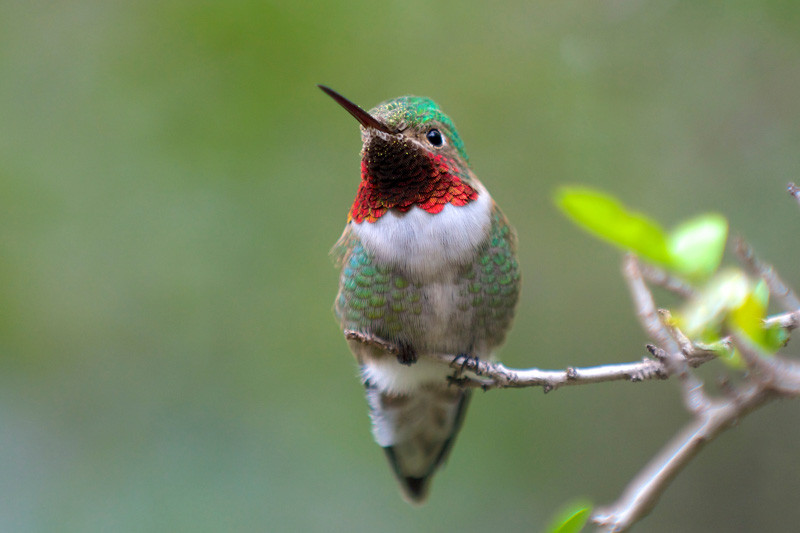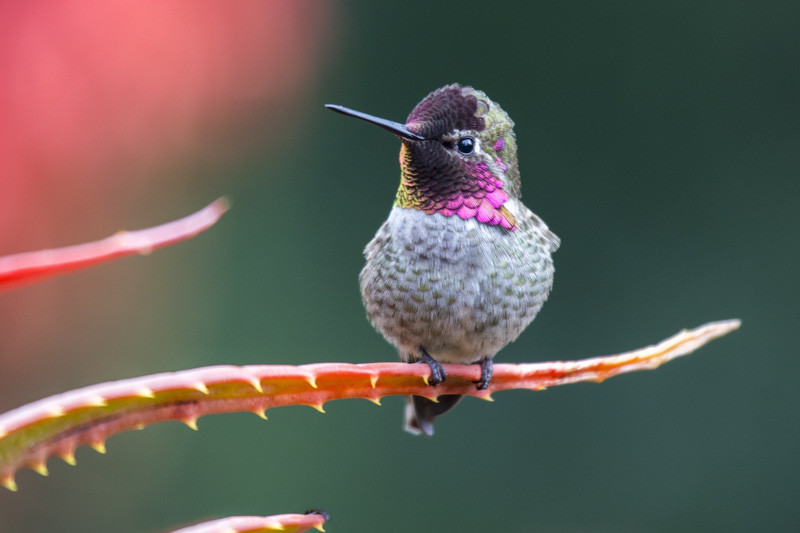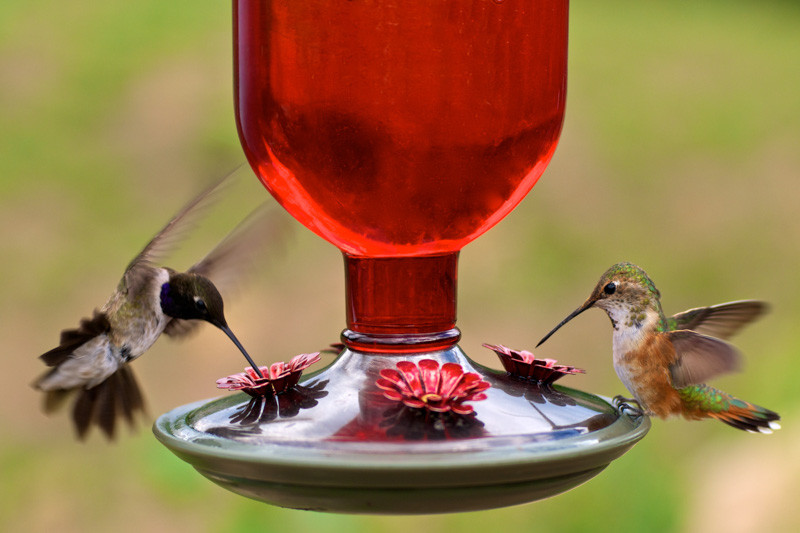A hummingbird is a small bird belonging to the family Trochilidae, known for its unique and remarkable characteristics. There are over 300 species of hummingbirds that are native to the Americas, with the highest species diversity found in South and Central America. These birds are known for their iridescent plumage, rapid wing-flapping, and extraordinary agility in flight.
Why Should I Attract Hummingbirds?
Attracting hummingbirds to your garden or outdoor space can provide various benefits, both for the environment and for your personal enjoyment. Here are some reasons why you might want to attract hummingbirds:
- Pollination: Hummingbirds are excellent pollinators. As they feed on nectar from flowers, they transfer pollen between plants, which is essential for the reproduction of many plant species. By attracting hummingbirds, you help maintain healthy ecosystems and promote biodiversity in your garden and surrounding areas.
- Pest control: Hummingbirds also consume insects and spiders, which can help keep pest populations in check. By attracting hummingbirds to your outdoor space, you can benefit from their natural insect control, reducing the need for chemical pesticides.
- Educational opportunities: Observing hummingbirds up close offers an excellent opportunity to learn about their unique behavior, anatomy, and ecology. This can be particularly engaging and educational for children, fostering an interest in nature and wildlife.
- Aesthetic appeal: Hummingbirds are beautiful creatures with their vibrant, iridescent plumage and graceful flight. Attracting hummingbirds can add color, movement, and life to your garden or outdoor space, enhancing its visual appeal and creating a more inviting atmosphere.
- Relaxation and enjoyment: Watching hummingbirds can be a soothing and enjoyable way to unwind and appreciate the beauty of nature. Their presence can promote relaxation and mental well-being, providing a calming escape from everyday stresses.
- Supporting local wildlife: Attracting hummingbirds and creating a hummingbird-friendly environment contributes to the conservation of these unique birds and the local ecosystems that they inhabit. By providing food, water, and shelter, you can help sustain hummingbird populations and promote their overall well-being.
In summary, attracting hummingbirds offers numerous benefits, ranging from environmental support to personal enjoyment and relaxation. By creating a welcoming environment for these fascinating creatures, you can enhance the beauty of your outdoor space and contribute to the health of local ecosystems.
 A Ruby-throated Hummingbird (Archilochus colubris) – The only species of hummingbird that breeds in eastern North America
A Ruby-throated Hummingbird (Archilochus colubris) – The only species of hummingbird that breeds in eastern North America
How to Attract Hummingbirds?
Attracting hummingbirds to your garden or outdoor space involves providing them with food, water, shelter, and nesting sites. Here are some tips to create a hummingbird-friendly environment:
- Plant nectar-rich flowers: Planting flowers that produce abundant nectar is a natural way to attract hummingbirds. Choose native plants with tubular-shaped flowers in bright colors, particularly red, orange, and pink. Some examples include trumpet vine, bee balm, salvia, and fuchsia. Make sure to select plants with different blooming periods to provide a continuous food supply throughout the season.
- Set up a hummingbird feeder: Hang a hummingbird feeder filled with homemade or store-bought nectar to provide an additional food source. Make sure to clean and refill the feeder every few days, especially during warm weather, to prevent the growth of harmful bacteria and mold.
- Provide water: Hummingbirds need water for drinking and bathing. Set up a shallow birdbath, a fountain with a gentle mist, or a small drip system to offer fresh water. Make sure to clean the water source regularly to maintain cleanliness.
- Create shelter and perching spots: Provide shelter and perching spots for hummingbirds by planting trees and shrubs of different heights. This will give them places to rest, seek shade, and hide from predators. Native plants are ideal, as they provide natural habitat and may offer additional food sources like insects and spiders.
- Provide nesting materials: Encourage hummingbirds to nest nearby by providing suitable nesting materials. They often use soft plant fibers, lichen, and spider silk to build their nests. You can hang strips of natural fibers, such as cotton, or commercially available nesting material in your garden to help them find suitable materials.
- Minimize pesticide use: Reducing or eliminating pesticide use in your garden can help create a healthier environment for hummingbirds and other wildlife. Many pesticides can harm hummingbirds directly or indirectly by reducing their food sources, such as insects and spiders.
- Keep cats indoors: Cats can pose a significant threat to hummingbirds and other birds. To protect hummingbirds from predation, keep pet cats indoors or supervise them while outside.
By following these tips, you can create a welcoming environment that attracts hummingbirds and supports their well-being. Enjoy the beauty and excitement these tiny, fascinating creatures bring to your garden or outdoor space.
 Anna’s Hummingbird (Calypte anna): A year-round resident of the western United States
Anna’s Hummingbird (Calypte anna): A year-round resident of the western United States
How to Make Hummingbird Nectar?
Feeding hummingbirds can be both fun and rewarding. Making hummingbird nectar is simple and requires only two ingredients: water and white granulated sugar. Here’s a basic recipe for creating homemade hummingbird nectar:
Ingredients:
- 4 parts water
- 1 part white granulated sugar
Instructions:
- Measure out 4 cups of water and 1 cup of sugar. This ratio ensures that the nectar closely resembles the natural sugar content found in flowers.
- Combine the water and sugar in a saucepan. Heat the mixture over medium heat, stirring occasionally, until the sugar dissolves completely. There’s no need to bring the mixture to a boil; heating it just helps the sugar dissolve more easily.
- Remove the saucepan from the heat and let the nectar cool to room temperature.
- Once the nectar has cooled, fill your hummingbird feeder with the homemade nectar. Any leftover nectar can be stored in the refrigerator for up to two weeks.
- Hang the feeder in a location that’s visible and accessible to hummingbirds, ideally near flowers that attract them.
Remember to clean your hummingbird feeder and replace the nectar every few days, especially in warm weather, to prevent mold growth and harmful bacteria.
Note:
- Do not add red food coloring or artificial sweeteners to the nectar, as these can harm hummingbirds. The natural red color of many hummingbird feeders is sufficient to attract them.
- Do not use honey, as it is not suitable food for hummingbirds. Honey can develop harmful mold and bacteria when diluted in water. These microorganisms can harm hummingbirds and cause severe health problems or even death.

Where to Place the Hummingbird Feeder?
Choosing the right location for your hummingbird feeder is important to attract hummingbirds and ensure their safety. Here are some tips for placing a hummingbird feeder:
- Visibility: Place the feeder in a spot where hummingbirds can easily see it. If possible, choose a location near brightly colored, nectar-rich flowers that hummingbirds are already visiting. This will help them discover the feeder more quickly.
- Shelter: Hang the feeder near trees or shrubs to provide the hummingbirds with a nearby place to perch and take cover from predators. However, avoid placing it too close to dense foliage, which could conceal lurking predators, such as cats or larger birds.
- Shade: Position the feeder in a partially shaded area to help prevent the nectar from spoiling too quickly due to direct sunlight and heat. However, ensure that there is enough light to make the feeder visible to the birds.
- A safe distance from windows: To prevent collisions, place the feeder at least 10-15 feet away from windows or consider installing window decals to alert birds to the presence of glass.
- Accessibility: Hang the feeder at a height that is convenient for you to clean and refill regularly, typically between 4-6 feet (120-180 cm) off the ground. This height also allows you to easily observe the birds without disturbing them too much.
- Spacing multiple feeders: If you have multiple feeders, space them out to reduce competition among hummingbirds and allow more birds to access the food. This can help create a more peaceful feeding environment and encourage more birds to visit your feeders.
- Away from busy areas: Keep the feeder away from busy areas, like doors, walkways, or children’s play areas, to minimize disturbance to the hummingbirds and reduce the risk of accidents or injuries.
Do Not Forget to Clean the Hummingbird Feeder!
Cleaning the hummingbird feeder is essential for maintaining a healthy and safe environment for the birds. Neglecting to clean the feeder can result in the growth of mold, bacteria, and fermentation of the nectar, which can harm or even kill hummingbirds. Here are some tips for cleaning your hummingbird feeder:
- Frequency: Clean the feeder every 2-4 days, or more frequently in hot weather, as heat can cause the nectar to spoil more quickly. If you notice that the nectar has become cloudy or discolored, or if you see any mold or debris in the feeder, clean it immediately.
- Disassemble the feeder: Remove any parts that can be taken apart to ensure thorough cleaning. This may include the base, feeding ports, or other removable components.
- Cleaning solution: Prepare a cleaning solution by mixing warm water with a small amount of unscented dish soap. You can also use a solution of one part white vinegar to four parts water for a more natural cleaning option.
- Scrubbing: Use a bottle brush or an old toothbrush to scrub the inside of the feeder and all removable parts, removing any mold, debris, or residue. Pay particular attention to the feeding ports, which can become clogged with mold or debris.
- Rinsing: Rinse the feeder and all parts thoroughly with clean water to remove any soap or vinegar residue. Rinse multiple times to ensure that all cleaning agents have been completely removed.
- Drying: Allow the feeder to air dry completely before reassembling and refilling it with fresh nectar. This helps prevent the growth of mold and bacteria.
- Deep cleaning: Periodically, you may need to perform a deep cleaning using a 10% bleach solution (1 part bleach to 9 parts water) to remove any stubborn mold or bacteria. Soak the feeder and its parts in the bleach solution for about 10 minutes, then scrub and rinse thoroughly with clean water. Allow the feeder to air dry completely before refilling it with nectar.
By regularly cleaning your hummingbird feeder, you can help ensure the health and safety of the birds and enjoy their visits to your garden or outdoor space.
While every effort has been made to describe these plants accurately, please keep in mind that height, bloom time, and color may differ in various climates. The description of these plants has been written based on numerous outside resources.
 A Ruby-throated Hummingbird (Archilochus colubris) – The only species of hummingbird that breeds in eastern North America
A Ruby-throated Hummingbird (Archilochus colubris) – The only species of hummingbird that breeds in eastern North America Anna’s Hummingbird (Calypte anna): A year-round resident of the western United States
Anna’s Hummingbird (Calypte anna): A year-round resident of the western United States